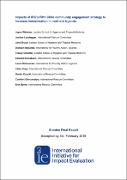| dc.contributor.author | Webster, Jayne | |
| dc.contributor.author | Landegger, Justine | |
| dc.contributor.author | Bruce, Jane | |
| dc.contributor.author | Malunda, Dickson | |
| dc.contributor.author | Chantler, Tracey | |
| dc.contributor.author | Kumakech, Edward | |
| dc.contributor.author | Schmucker, Laura | |
| dc.contributor.author | Kiapi, Lilian | |
| dc.contributor.author | Kozuki, Naoko | |
| dc.contributor.author | Olorunsaiye, Comfort | |
| dc.contributor.author | Byrne, Erin | |
| dc.date.accessioned | 2020-11-11T11:50:33Z | |
| dc.date.available | 2020-11-11T11:50:33Z | |
| dc.date.issued | 2019 | |
| dc.identifier.citation | Webster, J., Landegger, J., Bruce, J., Malunda, D., Chantler, T., Kumakech, E., ... & Byrne, E. (2019). Impacts of IRC’s Fifth Child community engagement strategy to increase immunisation in northern Uganda. | en_US |
| dc.identifier.uri | https://hdl.handle.net/123456789/196 | |
| dc.description.abstract | The 2011 Uganda Demographic and Health Survey (UDHS) reported that the national coverage of the third dose of the combined diphtheria, pertussis, tetanus vaccine (DPT3) among children 12-23 months of age was 73%, and only 52% were fully immunized.
Intervention overview
In search of innovative ways to increase immunization coverage, the IRC, in coordination with the Uganda Ministry of Health, piloted from August 2015-April 2016 an mReach application (mReach) and community engagement strategy (the ‘Fifth Child’ intervention), working with Village Health Teams (VHTs) to identify immunization defaulters and re-enter them into the vaccination schedule. Based on positive results of this pilot, the IRC received funding from 3ie to scale and evaluate the impact of this intervention. The goal of the ‘Fifth Child’ intervention was to increase immunization coverage through defaulter tracing and targeted service delivery, facilitated by the mReach data platform and community engagement strategies. The intervention was implemented from mid-September 2016 to mid-September 2017.
The underlying hypothesis of the intervention is that data-driven, targeted community engagement would facilitate more effective defaulter tracing and contribute to increased immunization coverage in hard-to-reach communities. The project has two main components. The first is supporting activities aimed at strengthening the health system (support for outreaches, transport of vaccines and supplies, financial support for VHTs to attend community engagement meetings with health care workers and community leaders, etc.). The second component, mReach with community engagement, included continuous newborn registration, quality VHT home visits for immunization due and defaulter tracking, and community leader involvement and co-management of outreaches based on defaulter data. | en_US |
| dc.language.iso | en | en_US |
| dc.subject | Child community engagement | en_US |
| dc.subject | strategy to increase immunisation | en_US |
| dc.subject | Northern Uganda | en_US |
| dc.title | Impacts of IRC’s Fifth Child community engagement strategy to increase immunisation in northern Uganda | en_US |
| dc.type | Article | en_US |

